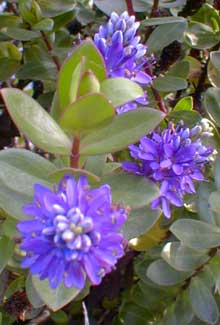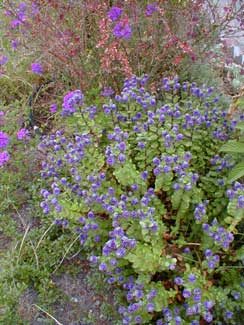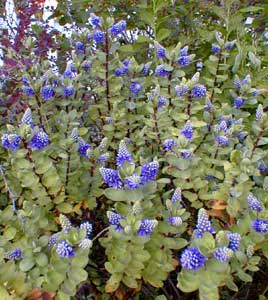
New Zealand's
Hebe 'Autumn Glory'
"Not to the shades shall the youth descend,
who for country hath perished;
Hebe awaits him in heaven,
welcomes him there with her smile;
There, at the banquet divine,
the patriot spirit is cherished;
Gods love the young who ascend
pure from the funeral pile."
-James Gates Percival
1795-1856
1795-1856
This commonly available Hebe cultivar is called 'Autumn Glory' in New Zealand & North America, but is occasionally offered as 'Autumn Beauty' in England.
Few catalogs give a species for this Hebe, so I suppose it is a mixed-up hybrid derived from select cultivars of Pacific Rim & New Zealand native shrubs. It was apparently developed early in the 20th Century in Ireland, without records of how the popular cultivar was developed.
Short of someone undertaking DNA analysis at considerable expense, there are presently only guesses as to its parentage. To my eye it looks so much like H. speciosa that I had personally guessed that to be the main part of its ancestry. But the Hebe Society following Graham Hutchins in Hebes Here & There (1997) suggests its parents are 'Franciscana Blue Gem' (i.e., H. elliptica x speciosa) pollinated by H. pimeleoides. Lawrie Metcalf inInternational Register of Hebe Cultivars (2001) suggests that it may be H. pimeleoides x vernicosa.
 I obtained 'Autumn Glory' in 1999 when we bought the house. At that time I was planting sundry evergreens to establish centerpieces that would retain some interest in winter, & it seemed to me that a couple of Hebes were just the thing.
I obtained 'Autumn Glory' in 1999 when we bought the house. At that time I was planting sundry evergreens to establish centerpieces that would retain some interest in winter, & it seemed to me that a couple of Hebes were just the thing.It was originally planted in a well-watered area near a Hishiki Willow & a Boxleaf Hebe. In that location it took a year to become rangy & downright ugly. So I hard-pruned it & let it start over, only to see it become just as rangy, but this time worse because it was also creeping around on the ground like it wished it was some kind of vine. The boxleaf hebe near it was growing rapidly in a much more shapely manner, but 'Autumn Glory' I began to dislike.
Eventually I gave up on it & moved it to the street margin. This was before the street margin itself became an elaborate garden, when the location was still more or less a place of exile for plants that disappointed me. In this dryer location the Hebe remained more compact & appealing. Over time this area became a blossoming sun-garden, with 'Autumn Glory' extremely effective & beautiful in the array.
With drought-hardy perennials increasingly hemming in the hebe, it added considerably to the overall texture of a spot that had become nothing short of exciting. It ceased the semi-prostrate behavior it had developed in the wet location, returning to its original upright mounding growth, & was no longer a weak distraction compared to its companions.
 When many of the perennials are fading toward winter, the evergreen presence & late blooms of this hebe keeps its area from seeming bare. Despite that I had long thought it could never be a favorite of mine, it became exceedingly pleasant. It no longer gets rangy so only rarely needs to be cut back. It grew into a substantial thigh-high shrub that demanded no more than very occasional & minor pruning to remain a beautiful thing. It does get thin in the center if not pruned back every other year.
When many of the perennials are fading toward winter, the evergreen presence & late blooms of this hebe keeps its area from seeming bare. Despite that I had long thought it could never be a favorite of mine, it became exceedingly pleasant. It no longer gets rangy so only rarely needs to be cut back. It grew into a substantial thigh-high shrub that demanded no more than very occasional & minor pruning to remain a beautiful thing. It does get thin in the center if not pruned back every other year.Since it had been my understanding that 'Autumn GLory' is not drought-hardy, it remains a bit of a marvel to me that it became a vastly more attractive shrub in what should have been a less than ideal spot for it.
The first photo at the top of the page is from October 2003. The flowers are short dense racemes of deep violet, quite pleasing against the shiny dark green leaves which, with close scrutiny, reveal a slim red rim.
It blooms first in June & July. The second photo is from July 2002; the purple flowers in the background are Verbena canadensis 'Homestead Purple'. The third photo is from June 2004. 'Autumn Glory' usually stops flowering by August, but then begins reblooming in September, the autumn rebloom period being equal to or in some years more magnificent than the summer bloom. The autumn flowering is generally not finished until December, with a couple extra flowers occurring even in January as happened in 2004 following snowfall.
It took an awfully long while to become a rewarding shrub, but that is at least partially my fault for having first planted it in a spot it didn't care for. If it ever again gets homely, I know now that it can survive a hard pruning & start over nicely, but most of the time it needs only tip-pruning after it has bloomed, which keeps it compactly leafed & tidy.